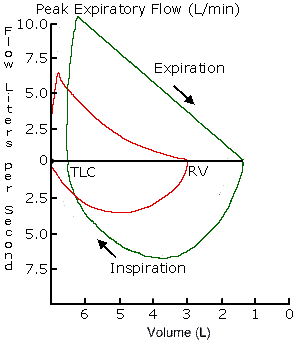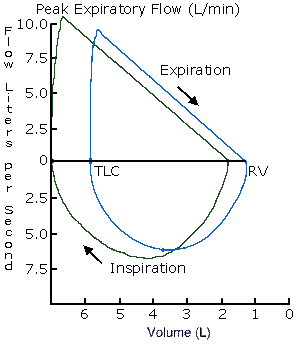- The patient has both a chronic and an acute process. Images 3.1 to 3.4 demonstrates the gross and microscopic appearance of the chronic process. Images 3.5 to 3.8 show gross and microscopic findings with the acute process. Describe both processes.
Chronic process: The airspaces are dilated grossly, and
respiratory bronchioles are dilated microscopically, with preservation of alveolar sacs. The result is the appearance of clubbed septa.
Acute process: There are gross areas of tan-yellow consolidation, and microscopically there are large collections of polymorphonuclear leukocytes in the alveoli along with some hemorrhage.
- What is the chronic process? How does it develop, and to what in the clinical history is it related?
The emphysema that occurs in heavy smokers, centrilobular emphysema, is characterized by central (proximal) destruction of lung lobules with loss of respiratory bronchioles and relative sparing of distal alveoli. Smokers have a greater number of neutrophils and macrophages in their alveoli. Smoking irritates alveolar macrophages, which in turn release neutrophil chemotactic factors, such as interleukin 8, thus recruiting neutrophils. In addition, nicotine is chemotactic for neutrophils, and smoke can activate the alternative complement pathway (an inflammatory cascade). Proteases, particularly elastase, are secreted by these neutrophils and macrophages. Proteases are enzymes that are capable of digesting lung tissue and these chemicals are responsible for the damage seen in emphysema. Oxidants and free radicals in smoke also inhibit the circulating alpha-1 antitrypsin in the lung that protects alveoli from proteases. Chronic irritation by smoke also can lead to chronic bronchitis with excess production of mucus. Smoke interferes with the ciliary action of the respiratory epithelium and the mucus cannot be cleared. This predisposes the smoker to secondary and repeated infections.
- This represents one form of this type of lung damage. Name the
other types, and what their respective etiologies are.
The other forms of emphysema are:
- Panacinar emphysema, related to the genetic absence or decrease of alpha-1-antitrypsin. The acini are uniformly damaged and dilated, from the respiratory bronchiole to the terminal acinus.
- Paraseptal emphysema, in which the proximal airway is normal and only the distal acinus is affected. Greatest in the apices subpleurally, and along connective tissue septa. Etiology is idiopathic.
- Irregular emphysema, in which acinus is irregularly involved, and process is associated with scarring.
- What is the acute process? How might this have developed and/or
be related to his hospital course?
The acute process is acute bronchopneumonia. With pancreatitis the patient is already ill, is probably not inspiring deeply, and is a set up for
hospital acquired pneumonia. Common bacterial organisms for hospital acquired pneumonias include: Staphylococcus aureus, Pseudomonas aeruginosa, Streptococcus pneumoniae, E. Coli, Klebsiella, and Hemophilus. The most common organism for community acquired pneumonias is Streptococcus pneumoniae.
- Draw the typical flow volume curve seen in obstructive and restrictive lung disease relative to normal.
Normal:

Obstructive:

Restrictive:

- What may reduce the FEV1 in a patient with chronic obstructive pulmonary disease (COPD)? What are the results of CO2 retention? What is the chief cause of hypoxemia?
Reduction in the FEV1 (forced expiratory volume in 1 second) may occur with excessive airway secretions, reduction in the number of small airways, loss of radial traction on airways, and loss of elastic recoil of the lung.
Retention of CO2 leads to respiratory acidosis, compensated by renal retention of HCO3. Over the short term the CSF pressure may increase somewhat and there can be decreased mentation.
The chief cause for hypoxemia in COPD is ventilation/perfusion (V/Q) inequality, as there is worse ventilation than perfusion. As time goes on, the vascular bed is reduced, pulmonary arterial pressure rises, and cor pulmonale ensues.

- What advance directives should be considered by this patient?
COPD is one of many common causes of death which creep up slowly over years, and don't cause any loss of decision making capacity. So these patients have plenty of time to discuss the future with their doctor, and make advance directives.
Also, "do not resuscitate" (DNR) orders are generic: they cover cardiac AND pulmonary resuscitation. Many people don't realize that, and think it only refers to cardiac arrest. Of course, most patients who do receive resuscitative measures die, which is why it is more accurately called DNAR (do not attempt resuscitation) since the term resuscitation implies a successful outcome. But it is important to remember also that most of those patients with chronic lung disease who don't die end up intubated. In the case of pulmonary diseases, this is probably a lifelong commitment--they will either die intubated, or decide they hate being intubated and die from voluntary withdrawal of the ventilator. (Is removal of ventilatory support assisted suicide? NO, it is letting the disease take its natural course.)
All of these issues should be openly discussed with the patient. Most patients will probably agree to being intubated once, though some will never want it. But even those who agree to it once will often say they never want that again, and should be made DNR (whoops, DNAR!)



